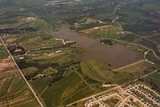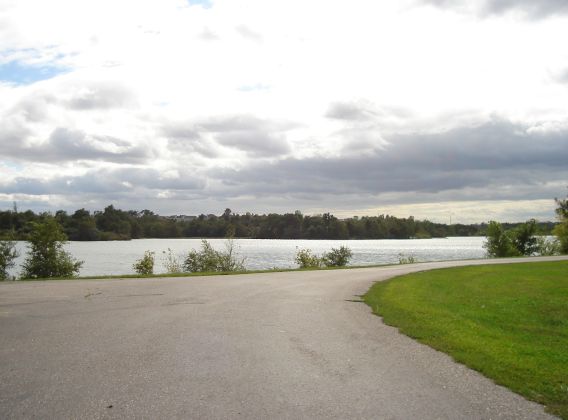
Standing Bear Lake
Encyclopedia
Standing Bear Lake, also known as Dam Site 16, is a park located at 6404 North 132nd street in West Omaha, Nebraska
.
The park has a 135 acre (0.5463261 km²) lake
with boating in the summertime, and ice skating
in the winter. The park and recreation area covers about 396 acres (1.6 km²) of land surrounding the lake, with a 131 acre (0.53013866 km²) wildlife area is located on the west side of the park.
Also known as Dam Site 16, the lake was originally built as a dam for flood control in the Lower Papio Valley. Recently the Nebraska State Game and Parks Commission added trout fishing to the lake.
The park is named after Chief Standing Bear
, who with his people, was told to leave his homeland along the Niobrara River
in northeast Nebraska for Indian Territory
in Oklahoma. After finding no supplies in Oklahoma and many of his people dying, including his own son, Standing Bear led 30 members of the Ponca Tribe back to Nebraska. He had to fight for the right to be recognized as a human being and his basic humanity, saying, "I am a man. The same God made us both."
 One of the earliest trails in the Omaha area is around Standing Bear Lake. The 6 feet (1.8 m) trail slopes in places and is 3.5 miles (5.6 km) around but does not completely encircle the lake. The path is narrow and not biker friendly.
One of the earliest trails in the Omaha area is around Standing Bear Lake. The 6 feet (1.8 m) trail slopes in places and is 3.5 miles (5.6 km) around but does not completely encircle the lake. The path is narrow and not biker friendly.
A large variety of fish may be found in the lake including walleye
, catfish
, bass
, bluegill
, crappie
, drum
, saugeye, yellow perch
, and trout
.
The park includes an remote control airplane flying field.
Ice skating is offered in the winter.
One unusual feature at Standing Bear is a wind organ
. Created by artist Douglas Hollis, the sculpture is a combination of metal pipes placed vertically in the ground. Each pipe has a hole in its side sound for filtering the wind and making sound.
Standing Bear sits in the middle of various housing developments. This makes it easy to get to, yet it still offers a secluded area to relax and get away from the city.
West Omaha, Nebraska
West Omaha is a geographic area of Omaha, Nebraska that comprises all points within the Omaha metropolitan area west of 72nd Street.-Demographics:...
.
The park has a 135 acre (0.5463261 km²) lake
Lake
A lake is a body of relatively still fresh or salt water of considerable size, localized in a basin, that is surrounded by land. Lakes are inland and not part of the ocean and therefore are distinct from lagoons, and are larger and deeper than ponds. Lakes can be contrasted with rivers or streams,...
with boating in the summertime, and ice skating
Ice skating
Ice skating is moving on ice by using ice skates. It can be done for a variety of reasons, including leisure, traveling, and various sports. Ice skating occurs both on specially prepared indoor and outdoor tracks, as well as on naturally occurring bodies of frozen water, such as lakes and...
in the winter. The park and recreation area covers about 396 acres (1.6 km²) of land surrounding the lake, with a 131 acre (0.53013866 km²) wildlife area is located on the west side of the park.
History
Standing Bear Lake park opened in 1977, and includes fishing and boating, trails, and picnic areas.Also known as Dam Site 16, the lake was originally built as a dam for flood control in the Lower Papio Valley. Recently the Nebraska State Game and Parks Commission added trout fishing to the lake.
The park is named after Chief Standing Bear
Standing Bear
Standing Bear was a Ponca Native American chief who successfully argued in U.S...
, who with his people, was told to leave his homeland along the Niobrara River
Niobrara River
The Niobrara River is a tributary of the Missouri River, approximately long, running through the U.S. states of Wyoming and Nebraska. The river drains one of the most arid sections of the Great Plains, and has a low flow for a river of its length...
in northeast Nebraska for Indian Territory
Indian Territory
The Indian Territory, also known as the Indian Territories and the Indian Country, was land set aside within the United States for the settlement of American Indians...
in Oklahoma. After finding no supplies in Oklahoma and many of his people dying, including his own son, Standing Bear led 30 members of the Ponca Tribe back to Nebraska. He had to fight for the right to be recognized as a human being and his basic humanity, saying, "I am a man. The same God made us both."
Features

A large variety of fish may be found in the lake including walleye
Walleye
Walleye is a freshwater perciform fish native to most of Canada and to the northern United States. It is a North American close relative of the European pikeperch...
, catfish
Catfish
Catfishes are a diverse group of ray-finned fish. Named for their prominent barbels, which resemble a cat's whiskers, catfish range in size and behavior from the heaviest and longest, the Mekong giant catfish from Southeast Asia and the second longest, the wels catfish of Eurasia, to detritivores...
, bass
Bass (fish)
Bass is a name shared by many different species of popular gamefish. The term encompasses both freshwater and marine species. All belong to the large order Perciformes, or perch-like fishes, and in fact the word bass comes from Middle English bars, meaning "perch."-Types of basses:*The temperate...
, bluegill
Bluegill
The Bluegill is a species of freshwater fish sometimes referred to as bream, brim, or copper nose. It is a member of the sunfish family Centrarchidae of the order Perciformes.-Range and distribution:...
, crappie
Crappie
Crappie is a genus of freshwater fish in the sunfish family of order Perciformes. The type species is P. annularis, the white crappie...
, drum
Sciaenidae
Sciaenidae is a family of fish commonly called drums, croakers, or hardheads for the repetitive throbbing or drumming sounds they make...
, saugeye, yellow perch
Yellow perch
The yellow perch is a species of perch found in the United States and Canada, where it is often referred to by the shortform perch. Yellow perch look similar to the European perch, but are paler and more yellowish, with less red in the fins. They have six to eight dark, vertical bars on their sides...
, and trout
Trout
Trout is the name for a number of species of freshwater and saltwater fish belonging to the Salmoninae subfamily of the family Salmonidae. Salmon belong to the same family as trout. Most salmon species spend almost all their lives in salt water...
.
The park includes an remote control airplane flying field.
Ice skating is offered in the winter.
One unusual feature at Standing Bear is a wind organ
Wind organ
A wind organ is a musical instrument designed to be 'played' by the wind. Designs of wind organs vary depending on the artist constructing the organ...
. Created by artist Douglas Hollis, the sculpture is a combination of metal pipes placed vertically in the ground. Each pipe has a hole in its side sound for filtering the wind and making sound.
Standing Bear sits in the middle of various housing developments. This makes it easy to get to, yet it still offers a secluded area to relax and get away from the city.

